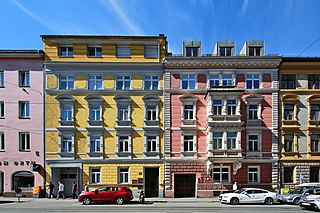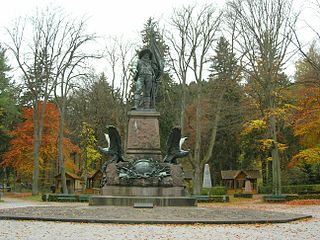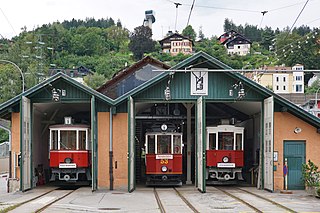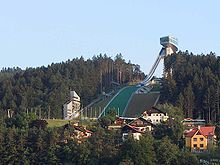
Innsbruck is the capital of Tyrol and the fifth-largest city in Austria. On the River Inn, at its junction with the Wipp Valley, which provides access to the Brenner Pass 30 km (19 mi) to the south, it had a population of 132,493 in 2018.

The history of Tyrol, a historical region in the middle alpine area of Central Europe, dates back to early human settlements at the end of the last glacier period, around 12,000 BC. Sedentary settlements of farmers and herders can be traced back to 5000 BC. Many of the main and side valleys were settled during the early Bronze Age, from 1800 to 1300 BC. From these settlements, two prominent cultures emerged: the Laugen-Melaun culture in the Bronze Age, and the Fritzens-Sanzeno culture in the Iron Age.

The 1964 Winter Olympics, officially known as the IX Olympic Winter Games and commonly known as Innsbruck 1964, was a winter multi-sport event which was celebrated in Innsbruck, Austria, from January 29 to February 9, 1964. The city was already an Olympic candidate, unsuccessfully bidding to host the 1960 Games. Innsbruck won the 1964 Games bid, defeating the cities of Calgary in Canada and Lahti in Finland. The sports venues, many of which were built for the Games, were located within a radius of 20 km (12 mi) around Innsbruck. The Games included 1,091 athletes from 36 nations, which was a record for the Winter Games at the time. Athletes participated in six sports and ten disciplines which bring together a total of thirty-four official events, seven more than the 1960 Winter Olympic Games. The luge made its debut on the Olympic program. Three Asian nations made their Winter Games debut: North Korea, India and Mongolia.

Andreas Hofer was a Tyrolean innkeeper and drover, who in 1809 became the leader of the Tyrolean Rebellion against the Napoleonic and Bavarian invasion, and against compulsory smallpox vaccination, during the War of the Fifth Coalition. He was subsequently captured and executed.

Seefeld in Tirol is an old farming village, now a major tourist resort, in Innsbruck-Land District in the Austrian state of Tyrol with a local population of 3,312. The village is located about 17 km (11 mi) northwest of Innsbruck on a plateau between the Wetterstein mountains and the Karwendel on a historic road from Mittenwald to Innsbruck that has been important since the Middle Ages. It was first mentioned in 1022 and since the 14th century has been a pilgrimage site, benefiting not only from the visit of numerous pilgrims but also from its stacking rights as a trading station between Augsburg and the Venice. Also since the 14th century, Tyrolean shale oil has been extracted in the area. Seefeld was a popular holiday resort even before 1900 and, since the 1930s, has been a well known winter sports centres and amongst the most popular tourist resorts in Austria. The municipality, which has been the venue for several Winter Olympics Games, is the home village of Anton Seelos, the inventor of the parallel turn.

Andreas Kofler is an Austrian former ski jumper.

Josef Speckbacher was a leading figure in the rebellion of the Tyrol against Napoleon.

The Bergisel Ski Jump, whose stadium has a capacity of 26,000, is a ski jumping hill located in Bergisel in Innsbruck, Austria. It is one of the more important venues in the FIS Ski Jumping World Cup, annually hosting the third competition of the prestigious Four Hills Tournament.

The Battles of Bergisel were four battles fought between Tyrolese civilian militiamen and a contingent of Austrian government troops and the military forces of Emperor Napoleon I of France and King of Kingdom of Bavaria against at the Bergisel hill near Innsbruck. The battles, which occurred on 25 May, 29 May, 13 August, and 1 November 1809, were part of the Tyrolean Rebellion and the War of the Fifth Coalition.

The 2012 Winter Youth Olympics (YOG) were an international youth multi-sport event featuring winter events that was planned to complement the Olympic Games. It featured athletes between the ages of 14 and 18.

The Hungerburgbahn is a hybrid funicular railway in Innsbruck, Austria, connecting the city district of Hungerburg with the city centre. The current line opened on 1 December 2007, replacing a previous alignment that operated from 1906 to 2005. The new Hungerburgbahn is one of the landmarks of the city, with stations designed by Zaha Hadid, and built by Leitner AG.

The Tyrolean Rebellion is a name given to the resistance of militiamen, peasants, craftsmen and other civilians of the County of Tyrol led by Andreas Hofer supported by his wife Anna and a strategic council consisting of Josef Speckbacher, Peter Mayr, Capuchin Father Joachim Haspinger, Major Martin Teimer and Kajetan Sveth, against new legislation and a compulsory vaccination programme concerning smallpox ordered by King Maximilian I of Bavaria, followed by the military occupation of their homeland by troops organised and financed by Napoleon I of the First French Empire and Maximilian I. The broader military context is called the War of the Fifth Coalition.

The Battle of Wörgl or Wörgel was fought on 13 May 1809, when a Bavarian force under French Marshal François Joseph Lefebvre attacked an Austrian Empire detachment commanded by Johann Gabriel Chasteler de Courcelles. The Bavarians severely defeated Chasteler's soldiers in series of actions in the Austrian towns of Wörgl, Söll, and Rattenberg. Wörgl is located 20 kilometres (12 mi) south of the modern-day German border on the upper Inn River.

The Tyrolean Museum Railways or Tiroler MuseumsBahnen (TMB) is a railway society in Austria whose aim is the preservation and/or documentation of the historically important branch lines (known as Localbahnen) and their rolling stock in the state of Tyrol.

Stubaital station was built in 1903 and, until 1983, was the terminus of the Stubai Valley Railway in Innsbruck. Since 1983 trains approaching from Fulpmes have been routed through the city of Innsbruck.

The 41st FIS Nordic World Ski Championships were held from 20 February to 3 March 2019 in Seefeld in Tirol, Tyrol, Austria. It was the second time Seefeld in Tirol hosted the world championships, the event having been hosted there previously in 1985.

The Seefeld Plateau is a montane valley and basin landscape in the North Tyrolean Limestone Alps about 500 metres above the Inn valley in the Austrian state of Tyrol. The plateau covers the valley basin around the villages of Seefeld in Tirol and Scharnitz as well as the valley of Leutaschtal.

The Innsbruck tram network is currently organised over six routes and has a total length of 44 kilometres (27 mi).

The Tirol Panorama with the Museum of the Imperial Infantry or Tirol Panorama is a museum in Innsbruck in the Austrian state of Tyrol, which is mainly important because it houses the Innsbruck Giant Panorama Painting.
The Andreas Hofer Kreuzer, also called the Hofer Kreuzer or Sandwirtszwanziger, was the name of the 20- and 1-kreuzer coins that were minted during the Tyrolean Rebellion in Hall in Tirol in 1809. The obverse depicts the Tyrolean Eagle and the inscription Gefürstete Grafschaft Tirol; the reverse shows the nominal value.




















